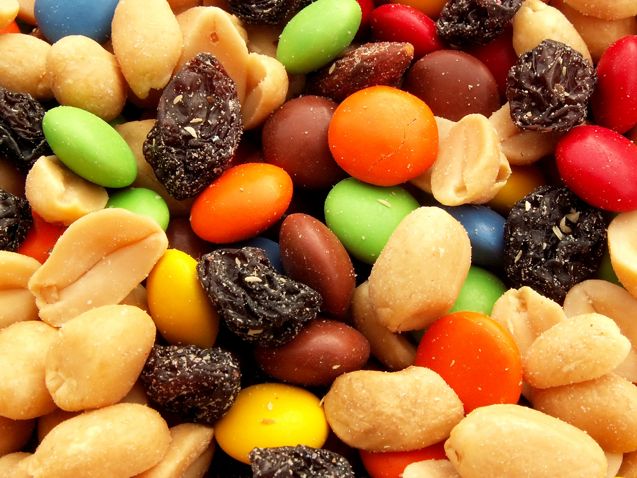The food industry is smart, and knows that most people are looking for healthier options these days. Unfortunately, though some conscientious companies are creating good low-fat, low-sugar, and low sodium options, others are simply dressing up unhealthy options to look healthy.
Shoppers need to be more careful than ever when seeking out the good stuff from the scams. Watch out for the following on your next trip to the grocery store.
- Dried fruit & nut mixes. Sound healthy, right? If companies stick with dried fruit and nuts, they are. But most add sugar coatings and lots of salt. Look for those with natural dried fruit, seeds, and unsalted nuts—check the ingredient deck and food facts to be sure.
- Lentil chips: These are supposed to be gluten-free, bean-based chips—advertised as being a good source of protein. Yet most contain only lentil “powder,” along with potato starch, oil, and salt. They have little fiber, often about the same number of calories as potato chips, and only 3-4 grams of protein. Even those labeled as having “light sea salt” often have hundreds of milligrams more sodium than regular chips.
- Veggie patties: If you’re on a vegetarian or vegan diet, these may look like a good option, but read carefully. Many of the prepared, frozen types have a lot of fillers (gums, cornstarch, yeast extract) and few real vegetables. Choose those that have real vegetables first on the ingredient list, and watch out for sodium and calorie levels.
- Protein shakes: These are often advertised as being full of protein, vegetables, fruit, and sometimes real dairy. Yet upon a closer look you may find that the protein comes from whey protein concentrate or soy protein isolate instead of from real food. They also like to fool you as to how much protein you’re getting by stating how much is in the bottle—when the bottle may contain two or more servings, which would cut that protein amount in half or more. Read carefully, and consider tempeh, quinoa, almonds, yogurt, kefir, or organic lean meat as better choices for real protein.
- Multi-grain and wheat breads: Everyone knows whole grains are better, so the food industry is now putting out a lot more multi-grain and whole wheat breads. Surely these are healthier? Look carefully. Some brands put “multi-grain” on the front of the package, but then actually use refined grains in the recipe. Read the label carefully—if it says “bleached” or “unbleached enriched wheat flour,” you’re not getting whole grains. Look for words like “whole grain,” “whole wheat,” “stoneground wheat,” “oats,” etc.
- Energy bars: Companies that manufacture these are even starting to conduct scientific research on them to convince us of their value. The KIND Plus Pomegranate Blueberry Pistachio + Antioxidants bar label says that a study by the Yale-Griffin Prevention Research Center showed that eating two bars a day helped prevent weight gain. Yet each bar has about 200 calories, and come to find out, the study didn’t put the bars up against any other food in a real test—they simply told 94 overweight adults to eat two bars a day, and eight weeks later found the participants hadn’t gained any more weight. (Nor did they lose any.) Try a real piece of fruit, a cup of natural trail mix, or low-fat cheese instead.
- Greek yogurt cereals and bars: Plain, natural Greek yogurt is full of protein and probiotics. But many food manufacturers are trying to use the healthy halo around Greek yogurt in products that aren’t so healthy. Take Greek yogurt cereals. Post Honey Bunches of Oats Greek Honey Crunch is one of them. The only thing they have that allows them to add the name “Greek yogurt” onto the label is a pinch of yogurt powder, mixed in with wheat, sugar, rice, corn meal, and oil. The powder is heat treated, so there are no live cultures. And the protein comes from milk protein isolate, not from the yogurt. Yogurt snack bars are typically made with Greek yogurt coating that has more sugar, palm kernel oil, palm oil, and shea oil than Greek yogurt. Just stick with the plain Greek yogurt.
- Vitamin water: Might be great if it was just water with vitamins, but most of these have about 32 grams of sugar, and the source of the vitamins is questionable, many coming from coal tar, sorbitol, and the like. Try real fruit instead—like a slice of lemon in your glass of water. Same with the bottled teas, by the way—watch for added sugar.
- Gluten-free foods: It’s getting more and more popular to shun wheat, and though some people have a real reason to—such as celiac disease or a wheat sensitivity—food manufacturers are trying to get us all on the bandwagon with prepared foods that may be lacking gluten, but have plenty of sugar, fat, and salt. Choose carefully if you must, but remember that processed foods are often low on the healthy-food chain. Healthy options typically have a whole grain, such as brown rice flour, as the first ingredient.
- Reduced-fat peanut butter. They take out the good-for-you fats and add in sugar instead. Check out the labels and you’ll see. Look instead for natural nut butters with no added oils or sugars.

No comments:
Post a Comment